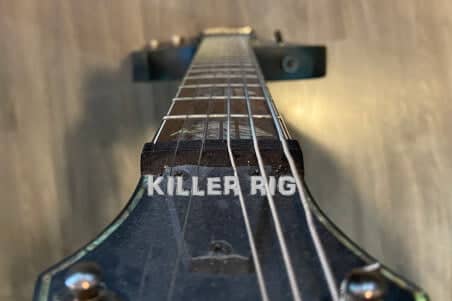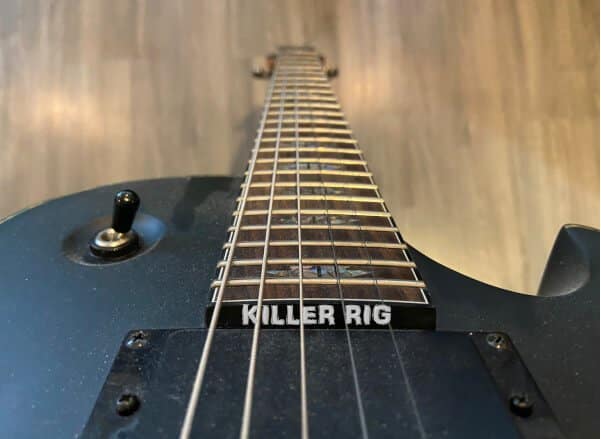Table of Contents
If you have ever looked down the neck of a guitar, you would see that it has a natural curve or bow to it. This is normal and is a result of the string tension applied to it. But over time, an issue can arise that is not normal, which is a warped guitar neck.
A warped guitar neck is the result of twisting that causes one side to have more of a bow or curve to it than the other. Depending on how the neck warps, one string will be further away from the fretboard at a certain point than it should be.
In this Killer Rig article, we are going to explore how a neck can become warped and what you can do to fix it.
What is a Warped Guitar Neck?
A warped guitar neck can cause all kinds of problems depending on how it has twisted. Because the neck of the guitar is made from wood, it can be altered by several conditions.
A warped guitar neck is the twisting of the wood that changed the relief of the strings. This can make one string come too close to the fretboard while another gets farther away.
This condition can make it almost impossible to play the guitar! With a warped neck, one or more strings will surely have fret buzz.
There are certain directions that the neck should bend, which are completely normal. But a warped neck is not one of them.
Have you ever looked down the neck of your guitar from the body to the headstock? If you see a slight twisting, you may have a warping issue.
What causes a Neck to Warp?
Guitar necks can warp for many reasons. We will explore some of the most common reasons that this can happen to your guitar.
Climate Change
Changes in temperature and humidity can cause wood to expand or contract. This can lead to a warped guitar neck over time as the wood adjusts to its new environment. This is the most common reason for a warped neck.
String Tension
The tension that the strings exert on the neck can cause it to warp over time. This is why it is so important to keep your guitar in tune and at the correct string tension.
Poor Construction
If a guitar neck is not constructed correctly, it can be more susceptible to warping. This is why it is so important to buy a quality guitar from a reputable manufacturer. Making sure the neck is also thick enough is crucial!
Accidents
If your guitar takes a fall or is involved in some other type of accident, it can cause the neck to warp. Be careful with your instrument and always keep it in a guitar case when you’re not playing it.
Improper Storage
If you don’t store your guitar properly, it can warp the neck. Always keep it in a case and in a cool, dry place.
A guitar is a delicate instrument! So if you take good care of it and prevent the issue above, you should never have a warped neck.

Warped Guitar Neck Symptoms
Most guitar players who start to develop fret buzz immediately assume the neck is warped. But this is not always the case. In most cases, the guitar simply needs a good setup.
But when a guitar neck is indeed warped or twisted, there are a few symptoms that begin to develop. They are as follows:
Fret Buzz
The number one symptom of a warped guitar neck is fret buzz. If the neck is warped, it will cause the strings to buzz against the frets when you play certain notes.
Depending on the direction the neck twists, this can become so bad that the guitar is simply not playable.
Notes Choke Out
Fretting out is a symptom that develops with warped necks. This is where the strings will not ring out as they are making contact with the fret.
It’s sometimes also referred to as choking out because the strings cannot be played properly. So if you play a string and the note fades out very quickly and sounds tinny, then it may be fretting out.
Poor Intonation
If your guitar’s intonation is off, it could be due to a warped neck. When the neck is warped, it causes the strings to vibrate at different frequencies.
This creates poor intonation. This is very noticeable as you begin to start fretting strings up the neck and the guitar sounds out of tune.
Action Issues
Have you noticed that the action on your guitar is getting higher or lower in random areas? It could be due to a warped neck.
A warped neck can cause the height of the strings to change unevenly. Do you notice one side of the neck has very tight action? But the opposite side is a large gap? Then it’s worth checking for twisting.
These are just a few of the symptoms that can occur when you have a warped guitar neck. If you notice any of these issues, it’s important to take your guitar to a qualified technician. Have it checked out so that you have the best playability.
How to Check if Your Guitar Neck is Warped
There are 2 main ways to check if your guitar neck is warped or not.
Eyeball The Neck

The best way to tell if your guitar neck is warped is by looking down it from the body to the headstock. If you see a twist in the wood, then you may have a warped neck. You will also want to make sure the lighting is excellent, as it may be too hard to see otherwise.
Maybe at first glance, you suspect the neck looks warped. Turn the guitar over and look at it again from headstock to body. You should see the twist in this direction as well.
You can also look at the neck from the side or in the playing position to see if it has a twist.
By looking at it from the side, you should see the fret ends disappear at the point of twisting. If all three of these eyeball tests confirm a warped neck, then there is one more thing to try.
Pro Tip: Make sure that you are aware of your finger board radius. Some guitars have a more prominent radius, and some people have mistaken it for a twist.

Feeler Gauge Test
This method is a bit more concrete than the eyeball test and will confirm if your guitar neck is warped or twisted. You will want to use feeler gauges for this test.
This is a thin metal tool that measures the space between two surfaces. You will also need a straight-edge ruler long enough to span nearly the length of the neck.
Start by placing the straight edge on one side of the neck on top of the frets. For example, place it in line, or parallel, with the high E and B string.
Then, take out your feeler gauge set. You want to start with the .010″ gauge or finger.
Now try and get the feeler gauge under the straight edge at the 7th fret. Record if it feels loose or tight. Next, set the straight edge parallel to the low E and “A” strings and repeat the process.
If one side is very loose and the other has trouble getting the feeler gauge under the straight edge, then the guitar neck is likely warped. You will have to determine if this measurement and the eyeball test confirm the twist or warped neck.
How To Fix A Warped Guitar Neck
If you have discovered that the neck on your guitar is warped, then there are a couple of things that you can try.
It’s worth noting, however, that once a neck was warped, it may never straighten out again. This is because the wood has memory, and may once again return to its twisted state.
Correct Environment
If your guitar has dried out due to improper storage, the neck might just straighten itself out. First, you want to remove the strings from the guitar. Then, you will want to store the guitar in an environment that has the right humidity and temperature.
From here, simply wait a couple of weeks to see if the wood absorbs the moisture and returns to its original position.
Sometimes this is all it takes. The opposite is true if the guitar has been exposed to too much moisture.
Most players are successful with this method because of poor storage conditions in an environment that is hostile to a guitar.
Balanced Tension String Set
Normally, the low E string side of the neck is under a greater amount of tension. As a result, this side of the neck will be pulled up when it twists. One solution is to obtain a string set that is better balanced.
You may have to combine a string set with different gauges to make this happen. For example, if you take an 11-50 string set and use the high E, B, and G.
Then, combine those with the Low E, A, and D from a 9-42 set. This might offset the tension issues.
Now the tension will be better balanced and over time the twist might work itself out.
Clamps and Heat
If the string set method doesn’t work, you can try using clamps and heat. This is a more advanced method. It should only be attempted if you are comfortable working with wood.
The idea is to place the guitar in a series of clamps to hold the body down. While allowing you to twist the neck back straight.
The truss rod should be loosened beforehand in order to have the best results.
You will need a way to heat the wood so that it becomes more pliable. A heat gun or even a clothes iron has been known to work.
Be careful not to overheat the wood as this can damage the guitar.
Do your best to prevent any hot surfaces from touching the guitar directly. The finish could be damaged. You may also simply adjust the heat in the room and add humidity and let it sit for several days.
Conclusion
A warped guitar neck can be very hard to fix. If it’s a new guitar, simply bring it back to the shop that you purchased it from.
There may have been an issue in manufacturing. If it’s an older guitar, have a good technician look at it and see if it can be fixed.
In some cases, when the neck cannot be fixed, you may have to replace it. This might be the only way to have the guitar return to a good, playable condition. This is normally the suggested method when it comes to an electric guitar with a bolt-on neck.

